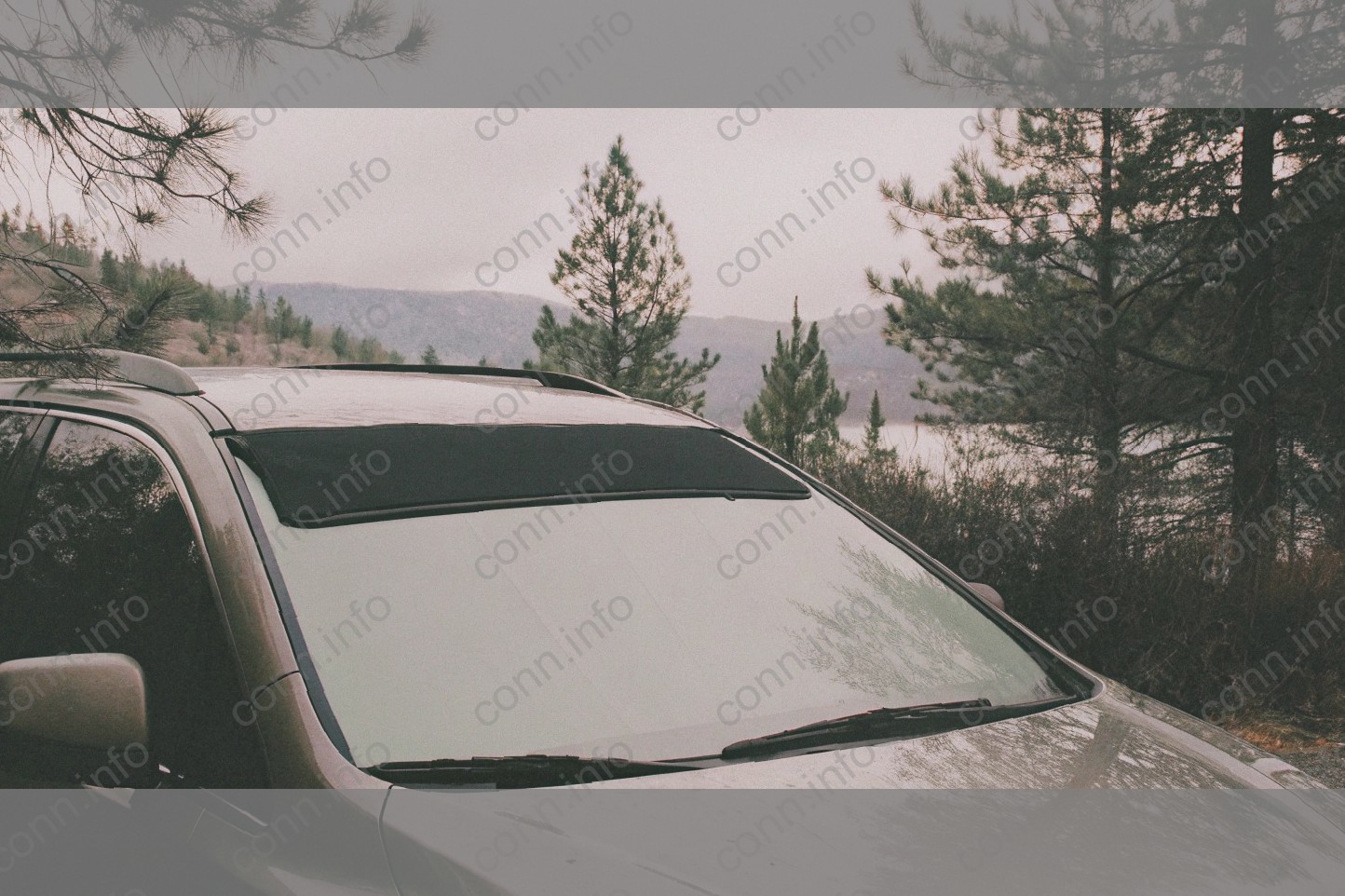Summary of Window Tint Restrictions in Idaho
Idaho defines a few terms that are unique to window tinting. The first term is VLT, which means the percentage of visible light allowed in through the film and the window. Idaho has not only adopted the term VLT but has also defined it as the visible light transmitted through the window, expressed as a percentage. It is measured by a spectrophotometer photometer, which means the light is shone through the window at a specified angle and the intensity of the light transmitted is measured.
All passenger vehicles in Idaho are required to have a maximum tint darkness of 35 percent VLT. The entire windshield may contain tinted glass except in the area above the AS-1 line, a tan line about 5 inches below the top of the windshield. The tint on this part of the window cannot be any darker than the vendor’s recommendation.
As an example, if you purchased the dark tint that allows 28 percent of VLT, the photo will show 28 percent VLT. If you don’t understand how to read the photo, a law enforcement officer or his supervisor may measure the window tint in the same manner to double check the measurement. As another example, if you purchased a translucent tint that allows 62 percent of VLT, the photo from the machine will show 62 percent VLT measurement. This means there is no violation.
The front side windows must also have no darker than 35 percent VLT tint darkness , while the passenger side windows can have no darker than 20 percent VLT tint darkness. The driver’s side window and front passenger side window must have no darker than 20 percent VLT tint darkness. For the rear windows of passenger vans and SUVs they must have no darker than 20 percent VLT tint darkness.
If you have a light-transmitting tint that allows only a certain percent of VLT, the state allows a 4 percent error factor. Thus, if your tint allows 35 percent VLT, the state will allow 31 to 39 percent VLT darkness. The state recognizes that the human eye may see a tint as different than an instrument.
The state also requires that the tint be installed on or after January 1, 1988. However, tint is permitted even if it is older than that as long as it meets the light transmittance rules in the code. There is no requirement in Idaho that the tint be certified. Idaho tint law states that the tint must be labeled to show level of reflectance, shade description and name of the manufacturer and installer.
Idaho requires that the entire windshield contain a tinted strip that may not extend more than 4 inches below the AS-1 line and have no legal tint darkness. The AS-1 line is tan and exists on all passenger vehicles manufactured after 1967.

Legal Tint Darkness for Passenger Vehicles
The legal tint limits in Idaho can vary depending on the type of vehicle you own. The window tint laws in Idaho break down differently for sedans, SUVs and vans, and trucks.
For sedans, the front windshield has a VLT of no less than 35% for any standard tint and no less than 6% for a certified tinted window certificate issue from a licensed company in Idaho. The front two windows must be at least 35% VLT. The back window tint has no requirement, while the rear window tint cannot be no more than 6% VLT.
For SUVs and vans, the legal tint limits for the windows in your car is the same standard as the sedans. The VLT for the front windshield is at least 35%. The front two windows are at least 35% VLT. The back window tint has no requirement, while the rear window tint cannot have no more than 6% VLT.
Trucks in Idaho have the same window tint requirements as sedans, SUVs and vans. There is one difference in the SB 1408 bill signed by Gov. Butch Otter that allows for trucks to have a legally tinted windshield that is not tinted. This means that your windshield can have at least 35% VLT or be untinted altogether.
Exceptions to the Standard
Particular circumstances may allow for greater tint on your vehicle than allowed under Idaho law. However, many of the follow exceptions require a doctor’s note or an official form. A certified optometrist in Idaho needs to fill out a forms stating the need for tinted windows for a medical reason. This form must be shared with authorities such as the Department of Transportation, the Department of Motor Vehicles, and your insurance provider. Any commercial vehicle may also receive a waiver on their tint limitations but must apply at the DMV. These exceptions are only possible after they have been approved and the window film is tested at a laboratory. Once passed, you will receive a sticker that you must place on the vehicle that also lists the parking and expiration of the approval. The approval is subject to testing by all agencies, not merely the DMV. Importantly, you will not be able to switch vehicles after getting these exceptions. They only apply to a single vehicle, and you will have to undergo the entire process to get approved for a new car.
Penalties for Violating Idaho Tint Laws
Violating the window tint restrictions in Idaho can result in fines and/or required modification of your vehicle within a prescribed period of time. Generally, a first-time passenger vehicle offense will be fined $67. A van, sport utility vehicle or truck will be fined $87 for their first offense. Repeat and subsequent offenses can bring harsher penalties. If you fail to modify your vehicle within the designated time-period , you may be required to appear before a judge. The judge has the discretion of imposing jail time, additional fines or community service if the lapse is egregious. However, the majority of enforcement is left to the discretion of the officer, who can issue you a warning or citation.
FAQs
Many individuals relocating to the state of Idaho have questions and concerns about window tinting regulations. Here are some commonly asked questions answered.
Q: Does my tinted windows affect my insurance rate?
A: Depending on your insurance carrier and the level of tint on your vehicle, your windows may or may not have any impact on your vehicle insurance coverage. In Idaho, there are tints that are illegal on cars since they present a potential hazard to other motorists, which would be illegal with or without tint. These driver safety issues concern insurers who probably will not insure a vehicle with a tint that would interfere with the driver’s ability to see the road. They also take into consideration the possibility of more accidents as a result of a driver’s inability to clearly see the road while driving with illegal window tints. This increased risk could adversely affect the cost of your vehicle insurance. There may be some insurance carriers that view illegal window tinting as a reason to deny you insurance or cancel your current policies. It is always best to review all insurance issues with your insurance agent regarding your tinted windows.
Q: If I am moving to Idaho from out of state, can I have my tinted windows?
A: You should be approved by the Ada County Sheriff’s Office for any windshields as well as driver and passenger windows that are tinted prior to moving to Boise and beginning residence in the city. This legislation took effect in 1999 in Idaho. If an out-of-state individual possesses tinted windows and must move to Boise due to work, the adjudicated individual can seek a possible exemption from complying with the tint law. The individual will have to write a letter to the sheriff requesting an exemption from the tint laws. An exemption may be granted for any driver and passenger windows.
Q: Are factory installed window tints legal?
A: All factory tinted windows are legal in Idaho. There should not be an issue with the tinting applied in the factory. The same is true for the manufacturer’s tinting of windows in recreational vehicles as well as boats, personal watercraft and all-terrain vehicles. A dark tint on factory windows is still legal in Idaho. However, any window tint applied after the vehicle’s purchase by a third party may be illegal. For example, a vehicle owner wanting to darken the tint on factory windows might have the tint reapplied. This process may not be performed in Idaho without a special exemption.
Tips on Choosing the Right Tint
When selecting the right window tint for your vehicle, there are some important factors to keep in mind while also staying within the limitations of the law. Here are some tips to help you make an informed decision: Consider the quality of the tint. Invest in high-quality window films to achieve optimum heat and UV protection while maximizing your privacy. Some brands offer enhanced protection from shattering glass, which adds an extra layer of safety to your vehicle. Take time to research the product features. While cheaper options may be available, they typically offer lower durable and limited features , such as blocking solar heat. Another consideration when selecting the right tint is color choice. Although Idaho State Law does not place any restrictions on color, choosing a tint that complements your vehicle will enhance its overall appearance. If you’re partial to black tinted windows, you can have them installed without worry of running afoul of the law. To ensure your tint is installed in accordance with the law, always have it installed by a professional. If you have friends who are in the tinting business, ask them to do it for you. Proper quality tint installations rarely cost more than $200.


